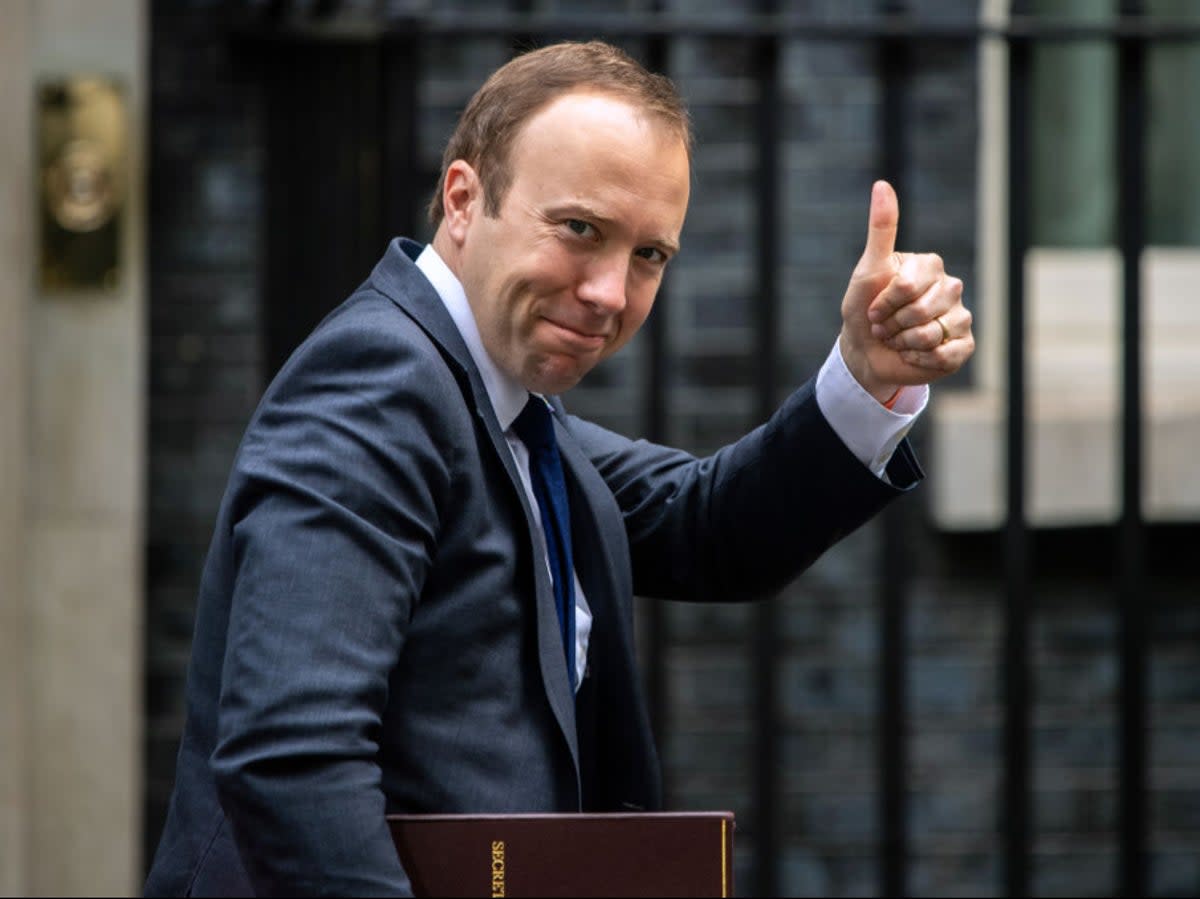Matt Hancock: The energetic health secretary who was brought down by his own lockdown rules

There was something poignant about the BBC radio profile of Matt Hancock broadcast in the early weeks of the pandemic, which explored the background of the minister at the heart of the national emergency, who was often on our screens, delivering the No 10 briefing. It started with a university friend of his, Gina Coladangelo, explaining how his parents had separated when he was “very young”, but that they had both happily remarried.
He grew up in Cheshire, and went to Exeter College, Oxford, where he took a first in the politicians’ degree – philosophy, politics and economics – followed by an MPhil in economics at Cambridge. He worked at the Bank of England, on the housing market, and then became an adviser to George Osborne, the shadow chancellor, in 2005. I first met him then: he was energetic, clever, and – as Osborne put it – a bit Tiggerish.
It was presumably around this time that he first encountered Dominic Cummings, who had been chief of staff to Iain Duncan Smith, the Conservative leader. Whenever it was, Cummings seems to have formed an early and abiding dislike for someone who was very much a conventional politician.
The next thing I knew, Hancock was an MP, often being interviewed on TV, often wearing a V-necked pullover that became his trademark. He was quick, loyal, hardworking and obviously destined for promotion. Indeed, he became a minister in the business department early on, and attracted envy from Conservative MPs who had served longer apprenticeships but had not attached themselves so presciently to the dispenser of patronage in David Cameron’s government.
His ability and his dedication not just to Mr Cameron but to the possible next prime minister, Mr Osborne, took him to the Cabinet Office after the Conservatives won the 2015 election. There, as paymaster general – a sort of all-purpose title that sounds better than “minister without portfolio” – he gained a better understanding of the centre of government.
Ironically, he made it into the cabinet after the fall of his patrons – and despite having backed Remain in the 2016 referendum. Theresa May appointed him secretary of state for digital, culture, media and sport. He must have been annoyed that Karen Bradley, his predecessor, got to add the “digital” to a departmental name that was already too long, because he liked to present himself as an up-with-the-tech politician, with a target to get ultrafast broadband to the whole country, along with his very own app so that constituents could engage with their “digital MP”.
His big break came with Boris Johnson’s resignation as foreign secretary in 2018 over May’s Chequers compromise for Brexit. Jeremy Hunt, the health secretary, went to the Foreign Office, and Hancock went to the health department. The next time I saw him, which was before the Tory leadership contest to replace May, he was in the office in Victoria Street where his career was eventually to end. His office opened onto a balcony which had a wonderful view of Westminster Abbey and the Palace of Westminster.
He stood for the Tory leadership when May resigned, in a crowded field, and won a respectable 20 votes in the first ballot before withdrawing from the contest and endorsing Johnson.
As health secretary, he was as energetic and diligent as ever. He worked hard to overcome the problems of the squeeze on NHS funding since 2010, eventually persuading May to promise substantial increases in spending – a promise designed to outbid the “£350m a week” on the side of the Brexit bus, which was taken up by Johnson when he became prime minister and put in his manifesto for the 2019 election.
He kept his job when Johnson became prime minister, and again when the Tories won the general election, a testament to his hard work and the prime minister’s sense that he wasn’t a threat. When the coronavirus struck, he responded with a determination to do the right thing, despite Cummings, Johnson’s chief adviser, almost immediately trying to get him sacked.
As the Covid-19 inquiry will no doubt find, Hancock’s response wasn’t perfect, but he stayed in what must have been one of the most difficult jobs throughout almost the whole pandemic. By May 2021, with the vaccine programme well under way, Cummings – who had left government at the end of the previous year – launched a full-frontal assault in front of the science and health select committee, trying to get rid not just of him, but of Johnson too.
Cummings’s attack failed, partly because it turned on the word “would”: Hancock had promised that patients discharged from hospitals to care homes “would” be tested – not “are being” tested. It was a politician’s escape, but then, just as he thought he had survived the worst that the virus and his enemies could throw at him, a huge story broke. The Sun had obtained a video from a security camera in Hancock’s office. It was a camera that neither Hancock nor his aides had ever noticed, installed when the office block on Victoria Street – never intended as a government building – had originally been built.
He had brought in Gina Coladangelo, his friend from Oxford University, as a “non-executive director” at the Department of Health – in effect as an additional political adviser. They began an affair, and had been caught on camera failing to observe the guidelines at the time that required social distancing.
Hancock apologised, resigned, separated from his wife and tried to start again, launching a new career as a TV personality while at the same time writing a book defending himself. Almost from the moment he became aware of a new virus in Wuhan, China, it seems that Hancock has been preparing for the public inquiry into the government’s handling of the pandemic. Now at last, he has his day in the witness stand.
